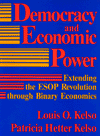by Louis O. Kelso and Patricia Hetter Kelso, Ballinger Publishing Company, 1986. Republished and currently available from University Press of America, 4720 Boston Way, Lanham, Maryland 20706
Reviewed by Arnold Brown
Marxism is not so much the vision that failed as it is the quest that failed. The ideal of economic equality continues to be an obsession that dominates both thinking and behavior in politics and government. So the failure of Marxism means only that other paths will be explored.
Increasingly, we are seeing the manifestation of this in attempts to articulate a new version of capitalism — “neo-capitalism.” Most of the articulations thus far are in the nature of attempts both to verify and to strengthen the links between capitalism and democracy. Simply stated, the argument is that, while there can be capitalism without democracy, there can be no democracy without capitalism. The problem then becomes how to equate this with capitalism’s original and continuing — even growing — tendency to create, maintain, and exacerbate inequality.
It is one of the ironies of history that if a visionary stakes out a position and stands by it long enough the world will eventually come around to where he or she stands. One such visionary is Louis Kelso, who for more than 30 years has advocated with uncommon vigor and persistence a vision of democratic capitalism that, while not espoused by a critical mass of theorists, is rapidly accumulating adherents. This vision is detailed at length in Democracy and Economic Power: Extending the ESOP Revolution, by Kelso and his wife-collaborator, Patricia Hetter Kelso.
Kelso first began to articulate his vision in The Capitalist Manifesto, co-written with philosopher Mortimer Adler, which was published in 1958. In subsequent books, Louis and Patricia Kelso further developed the thesis that the democratic exercise of economic power requires not the redistribution of income but changing the pattern of ownership of capital. Income is increasingly created by capital rather than labor, say the Kelsos, but the vast majority of people own no productive capital.
Being a practical man as well as a visionary, Kelso created a way to make his vision concrete — the Employee Stock Ownership Plan (ESOP). Kelso has had the satisfaction of seeing the ESOP grow from one small, bold experiment to a full-fledged movement. There are now several thousand ESOPs, encompassing more than 10 million workers.
It is only in visions, unfortunately, that dreams can remain undefiled. Kelso has also had the bitter disappointment of seeing his concept distorted into the non-ESOP leveraged buyout, so cleverly used by corporate raiders and self-seeking managers.
The Kelsos’ new book is an effort to reaffirm their dream. The authors restate, as vigorously as they have in the past, both their perception of the need for economic democracy and their belief in worker ownership of capital as the appropriate response. They show again how worker ownership of capital can be realized. And this time they make specific appeals to unions, which in the past have not been particularly receptive to either the concept or the practice of ESOPs.
Be warned: This is not an easy book to read. Even imbued as it is with the Kelsos’ missionary fervor, it is a dense and complex combination of economic, financial, and philosophical reasoning. But you will be rewarded for your labor. The Kelsos’ argument is logical, coherent, and even compelling.
Mainstream economists have persistently ignored the Kelsos. This book makes it hard to understand why they have done so and even harder to understand how they can continue to do so. Certainly the new technological revolutions are raising new questions about inequality. As more and more wealth is created by machines rather than people, how is that wealth to be distributed? Will we follow old patterns and tax robots to support idle workers? Or will we seek new roads to what promises to be a new world in the future?
Democracy and Economic Power illuminates one new road. Everyone concerned about how we get there from here should read it.
— Originally published in THE FUTURIST, July-August, 1987


